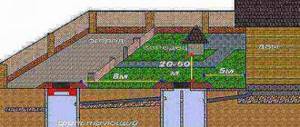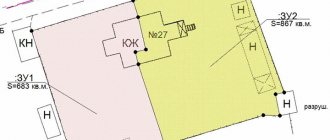Buildings and roads within the city are growing every year. During the construction and design process, it is necessary to find out the permissible distance from a residential building to the road (the standards are described in SNiP). Every home needs a fence to create comfortable conditions inside the yard. When installing it near a road, strict rules and regulations must be followed.
Distance from road
Primary requirements
The distance from the house to the road must comply with the rules in cities, towns and rural areas. Social standards necessary to ensure comfortable movement in SNT and individual housing construction are taken into account.
Passenger and cargo transport should not cause inconvenience to residents of houses.
Modern village
When designing, the minimum distance is calculated taking into account the provision of paths for pedestrians and the possibility of unhindered movement of fire trucks to any of the buildings. Attached premises are also taken into account. A fire ladder or lift must give employees access to any of the apartments or other types of premises, both in the city and in the rural settlement.
The legislation dictates the following standards for the distance from the road to the corner of the building:
- up to eight meters – building up to 10 floors;
- up to ten meters - for an apartment building above 10 floors.
SNiP 30-02-97 as amended in 2021 and SP 53.13330.2011 also do not allow the installation of overhead lines or planting trees in this area. The distance to the roadway must be maintained, as it is necessary to extinguish the fire. However, it is also possible to organize other traffic along this section.
Village area
You can fight the fire from the inside of the yard. In addition to the apartment building, it will be necessary to provide access from two sides. Thanks to this, it will be possible to prove to the expert that the construction was carried out correctly. During the construction process, you will also need to comply with other applicable codes and regulations.
Restrictions and basic distance norm
At what distance from the road a house can be built is regulated by two parameters at once. This is the norm for distance from the fence, prescribed depending on its size, the intensity of traffic flow per unit of time and compliance with the distance from the fence to the residential building. The latter is a necessary requirement of the Ministry of Health, which takes into account the possibility of pollution from traffic entering windows.
It should be 5 meters or more, depending on the type of road, and 3 meters from an alley or alley.
The distance from the railway to a residential building is no exception. The sanitary zone is considered to be 100 m, measured from the railway track (extreme axis), but much depends on the frequency of train movement and other conditions:
- the volume of cargo turnover carried out;
- the nature of the goods being transported, which may pose an immediate danger to residential buildings;
- noise levels, which are measured during periods of heavy traffic;
- the level of vibration to which buildings are exposed when the train moves along the paved track;
- number of paths;
- location of marshalling yards nearby.
In the video you can see special anti-noise measures taken to reduce the sanitary strip before construction.
If a train passes through an excavation, it is also permissible to reduce the sanitary protection zone to 50 m, but still in this zone the emphasis is on garages, warehouses or utility buildings, and green spaces are often simply planted.
In order not to violate existing rules and regulations, you need to follow the law, which states that any development plan is subject to approval by supervisory authorities. They will help to avoid mistakes in planning and landscaping.
The distance from the house to the road must comply with the rules in cities, towns and rural areas. Social standards necessary to ensure comfortable movement in SNT and individual housing construction are taken into account. Passenger and cargo transport should not cause inconvenience to residents of houses.
Distance from the road to the house according to SNiP standards
In the approved rules, the legislation dictates the following standards for the distance from the road to the corner of an apartment building (MKD) or a private low-rise building:
- there must be at least 5 meters from a private house to the road;
- to an alley or driveway - at least 3 meters;
- if they are designing a high-rise building, then the distance from the road will need to be increased to 8–10 meters.
Standards in SNT, private household plots and individual housing construction according to SNiP
There should be at least 25 meters from the edge of the highway to holiday villages, and 50 meters to residential buildings. If we are talking about a federal highway, then these indicators are doubled.
Norms for the neighborhood of a residential building and railway tracks
The distance from the railway to a residential building should be designed taking into account the need to create a sanitary zone. Its minimum is 100 m. If an additional noise-insulating fence is being erected or the canvas is located in a ravine, then it is allowed to reduce the value by half. The construction of buildings in SNT and individual housing construction, garages and other structures is allowed to be carried out immediately after the sanitary zone has ended.
When calculating the distance at marshalling yards, the value of freight turnover activity is used. The noise level and degree of flammability of the raw materials used are also analyzed.
Distances from the fence
Indentations from the boundaries of the land plot during individual construction
Regarding the minimum distance from the beginning of the territory of the section of the building walls and other buildings, some of which are without windows, the situation in this regard is as follows:
We recommend reading: Targeted assistance to low-income families in 2021 amount Krasnodar region
Every resident of our country, while carrying out any construction work in their own home, thought about whether there were legislative norms that defined clear boundaries in buildings, distances between houses, and so on.
What is the distance to retreat from the federal highway?
Roads are classified as this type if at least 1,400 cars pass along them during the day. The construction of such routes is under the control of current legislation.
Roads are designed strictly in compliance with GOST, sanitary and construction standards (SanPiN and SNiP). Railroad tracks for trains are also located at the maximum distance from urban and rural settlements. This is a legal requirement. Based on it, it is calculated at what distance from the road a private house can be built.
The roadside construction standard should not include the following objects:
- Buildings used for servicing vehicles.
- Buildings in which people will live.
- Public and other buildings that are not used in the process of servicing the highway.
Beautiful nature in the country
When choosing the width of the roadside strip, you will need to take into account the class of the road:
- 1st – 2nd class – from 75 m;
- 3rd – 4th class – from 50 m;
- 5th grade – 25 m;
- a bypass route or road around a populated area with a population of up to 250 people – 100 m;
- bypass road around a city with more than 250 inhabitants – 150 m.
Construction of buildings of any type is possible according to the law of the Russian Federation only outside the roadside. This group includes buildings with public purposes. For example, you can build a store or a roadside cafe here.
Minimum setbacks of buildings, structures, structures from the boundaries of land plots
1.1. If the urban planning regulations in relation to a certain territorial zone do not establish the maximum (minimum and (or) maximum) sizes of land plots, including their area, and (or) the maximum parameters of permitted construction provided for in paragraphs 2 - 4 of part 1 of this article , reconstruction of capital construction projects, directly in the town planning regulations in relation to this territorial zone it is indicated that such maximum (minimum and (or) maximum) sizes of land plots, maximum parameters of permitted construction, reconstruction of capital construction projects are not subject to establishment. (Part 1.1 introduced by Federal Law dated 07/03/2021 N 373-FZ) 1.2. Along with the limit parameters of permitted construction and reconstruction of capital construction projects specified in paragraphs 2 - 4 of part 1 of this article, the town planning regulations may establish other limit parameters of permitted construction and reconstruction of capital construction projects. (Part 1.2 introduced by Federal Law dated 07/03/2021 N 373-FZ).
Minimum setbacks from the boundaries of land plots in order to determine the places of permissible placement of buildings, structures, structures, outside of which their construction is prohibited, must be indicated on the drawing of the urban planning plan of the land plot (clause 3, part 3, article 44 of the Civil Code of the Russian Federation), the form of which approved by Decree of the Government of the Russian Federation dated December 29, 2021 No. 840. Construction of an object on a land plot must be carried out in accordance with the town planning plan of the land plot, which indicates the minimum setbacks from the boundaries of the land plot to capital construction projects on the basis of town planning regulations adopted by the local government body for territorial zone within which the given land plot is located.
Other standards
The standard distance to the house must be maintained if it is necessary to erect other buildings.
In the village
The distance is measured from the nearest wall. It should be:
- to the toilet – 12 meters;
- to the greenhouse – 1 meter;
- to the nearest residential building – 6 meters;
- to the bathhouse, which uses an external type of drain, – 8 meters;
- to aviaries with poultry on a plot in a village - at least 12 m;
- to the compost pit for the toilet - 20 m. The location is additionally coordinated with the presence of a well or borehole. Thanks to this, it will be possible to keep the water clean and suitable for use;
- from the garage to the fence - at least 1 m;
- The toilet should not be located next to the fence. You should retreat from it by at least 1 m. It is allowed for toilets to touch each other and bring them into one cesspool. However, this process is pre-agreed with other owners.
SNiP also contains a number of recommendations that must be followed in the process of planting shrubs. Tall varieties can grow unhindered at a distance of up to 2 m from the fence.
For tall plantings (fruit trees), you will have to retreat at least 4 m.
The measurement must be taken from the middle of the trunk. Only in this case will it be possible to obtain correct data.
Table of distance of buildings on individual housing construction and SNT sites in accordance with SNiP standards.
| An object | To neighbors' fence, m | To the border of the neighboring plot, m |
| Toilet | 1 | 1 |
| Garage | 1 | 1 |
Violation of the setback from the boundary during the construction of a house
Hello. Please help us deal with our difficult situation. I own a rectangular plot of land of 10 acres in the village. The plot is intended for personal farming, residential land. It was isolated back in the late 90s. The ownership title was registered only in 2021. Documents: basis - a state act on land ownership. In 2021, a log house was installed for the house, with an attic floor with a total area of 21 sq. m. m. It took a long time to build. While they were insulating, etc., the toilet was outside. We finished it somewhere in 2021. We turned on the gas. There is a BTI technical passport dated November 29, 2021. The ownership was registered in 2021. In 2021, they decided to reconstruct the house. The house was poorly insulated. They built an extension from gas blocks and installed a shower. I had to replace the roof. And the house seemed to lengthen. They invested a lot of money. No permits were taken for reconstruction. The log house was initially placed in a checkerboard pattern, i.e. if there is a street of village houses with facades on the road, then we placed them in the depths of the site so as not to border on neighboring houses, and the entrance to the site was made from the opposite side (conditions allowed). The fact is that when the log house was erected, only 1 meter was retreated from the boundary. At that time, they didn’t even think about building standards. The neighbor, to whose property the house is located closer, has a potato field. His plot is wider and more than 22 acres. Our house does not bother anyone. Therefore, until now we have lived quietly. This is the current situation. The neighbor decided to sell half of the plot, namely 10 acres (of his potato field), bordering us. I started to draw up the borders. He came to us to coordinate. Naturally, we thought that perhaps the new owners of the site might not like the fact that the house is located so close to the boundary line. Anything is possible. We asked the neighbor to formalize his consent that he is not against the location of our house, and to formalize this with the village council. My neighbor and I do not have a warm relationship. They put up a solid metal (corrugated sheet) fence and didn’t see each other. At one time he didn’t like the fact that we put up a solid fence, because... His potatoes aren't growing well. And it is clear that there were some neighborly reproaches. Elderly people.
In general, he refuses to sign an agreement that the house is located close to the boundary. And he doesn’t want to sell us the land (out of spite). And the fact that we do not sign an agreement for him (and we would sign, but we are afraid ourselves) for the boundaries of the site, then this means that it is not a problem. We will decide, he says, through the courts or in some simplified manner (if one of the neighbors does not agree on the boundaries of the site). Please tell me: can he register the plot without our consent? If the new owners sue us for demolition of the house, then what prospect awaits us? Or will our neighbor have a short circuit and will sue us? What excites me most, of course, is the house. It is our life. Thank you.
We recommend reading: How the refinancing rate of 1300 is applied to land lease agreements









